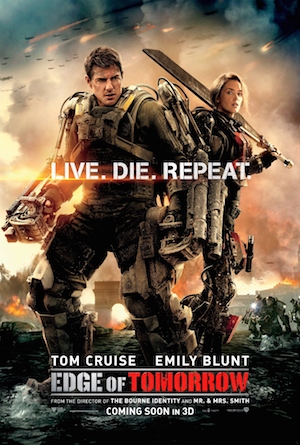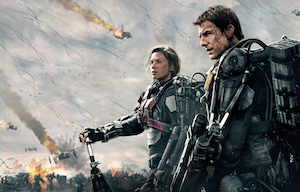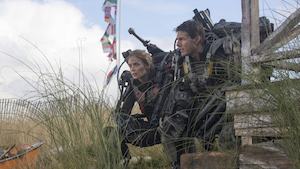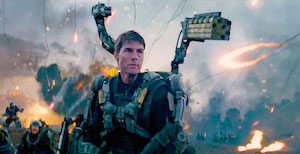 Tom Cruise has to relive the same hellish alien invasion over and over again in Edge Of Tomorrow, the latest sci-fi/action offering from director Doug Liman and a writing team that includes Cruise’s current collaborator Christopher McQuarrie. Borrowing the premise from the Japanese novel All You Need Is Kill, Edge Of Tomorrow has a central plot device that makes it stand out from other big budget, summer fare: Cruise’s character, Major William Cage is forced to relive the same day over and over, each time he dies. But where Bill Murray had to navigate his way out of Punxsutawney, Iowa; Cage has to relive a horrific beachhead invasion that ends with his horrible death, every time.
Tom Cruise has to relive the same hellish alien invasion over and over again in Edge Of Tomorrow, the latest sci-fi/action offering from director Doug Liman and a writing team that includes Cruise’s current collaborator Christopher McQuarrie. Borrowing the premise from the Japanese novel All You Need Is Kill, Edge Of Tomorrow has a central plot device that makes it stand out from other big budget, summer fare: Cruise’s character, Major William Cage is forced to relive the same day over and over, each time he dies. But where Bill Murray had to navigate his way out of Punxsutawney, Iowa; Cage has to relive a horrific beachhead invasion that ends with his horrible death, every time.
Indeed, Edge Of Tomorrow is essentially Groundhog Day meets Starship Troopers in a good way. Cage is a PR man who did an exceptionally good job of selling a war against an interplanetary threat to the global public, but when he’s asked to be part of on-the-ground documentary crew on the day of the invasion, he balks at what he knows will be a bloodbath, first by trying to coerce, then by blackmail and finally by just making a run for it. It’s a sharp move in a movie based on repetition to give Cage a lot of room for emotional growth, considering he’s the only one who gets to make lasting character growth. But a big difference between Cruise’s character here and Murray’s in Groundhog Day is that Murray’s had to become a better man, and Cruise’s just has to become a better weapon.
 Liman does an amazing job of making the battle scenes immediate, dangerous and involving. There are plenty of parallels between this beach invasion and similar beach invasions from the World Wars that go beyond just the European setting. The notion that the horrors of war are repetitive, and virtually indistinguishable over time, isn’t exactly a difficult metaphor to grasp, either. McQuarrie’s script and Liman’s direction also make Edge Of Tomorrow funnier than you’d expect. Again, this isn’t a Starship Troopers-level satire, but there’s more to Edge Of Tomorrow than additional footage for the Tom Cruise Running reel, though there’s that too.
Liman does an amazing job of making the battle scenes immediate, dangerous and involving. There are plenty of parallels between this beach invasion and similar beach invasions from the World Wars that go beyond just the European setting. The notion that the horrors of war are repetitive, and virtually indistinguishable over time, isn’t exactly a difficult metaphor to grasp, either. McQuarrie’s script and Liman’s direction also make Edge Of Tomorrow funnier than you’d expect. Again, this isn’t a Starship Troopers-level satire, but there’s more to Edge Of Tomorrow than additional footage for the Tom Cruise Running reel, though there’s that too.
But the real star of the movie on a technical level is the editing, which keeps the audience guessing on how many times Cage has relived a specific moment in time, and whether he’s coming to an event for the first time or has already experienced it. It’s sly, and it keeps the audience guessing during the first half of the movie, before disappointingly settling into typical action movie mode and using one too many montages.
Even with the excellent Emily Blunt, who gets to play an incredibly tough character that flies in the face of her usual type, the movie’s back half really drags, as her character Rita has to train him (montage) and then they have to escape the battlefield (montage) and then they have to locate their next objective (montage). Montage fatigue is a real thing and Edge of Tomorrow has it. By nature, a montage is designed to denote the passage of time and essentially speed up plot and character development, but it happens enough here that the entire narrative ends up being compressed and somewhat exhausting. Edge Of Tomorrow is less than two hours on paper, but it seems much longer.
In all, it gets off to an exciting and unpredictable start before settling into the typical formula, which doesn’t really serve the events that came before it in the movie. An original premise gets Edge Of Tomorrow far, but its reliance on big budget movie tropes cause the film to stall and drag well before the credits.




{ 1 comment }
Nice and a detailed review on Edge Of Tomorrow, good job.
Comments on this entry are closed.